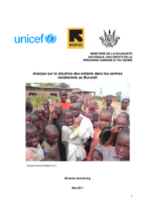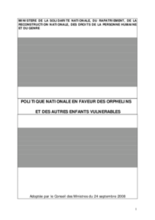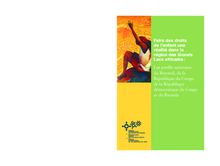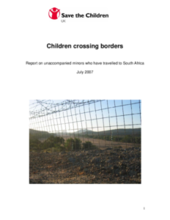childrens_living_arrangement
Displaying 31 - 40 of 42
Cet article fournit un aperçu utile des initiatives du Burundi dans le domaine de la protection des enfants, y compris le travail pour élaborer des normes minimales pour les établissements de garde d'enfants et de soutenir les enfants vivant dans
The report of this study responds to the objectives of identifying all the residential centres for children in Burundi, including the number of children residing in them; analysing the situation of children living in the centres and developing recommendations for the next steps
Le Gouvernement du Burundi, en collaboration avec l’UNICEF et l’ONG International Rescue Committee (IRC), a prévu de faire un état de lieux des centres résidentiels pour les enfants.
This brief presents the results of the mid-term evaluation of the New Generation project - a three-year project comprised of two components: 1) A VSLA intervention involving the establishment of Village Savings and Loan Associations (VSLAs) and th
This examination of Burundi’s Second Periodic Report to the Committee on the Rights of the Child includes a section on Alternative Care and Family Environment that details Burundi’s progress and challenges in areas such as regulation of adoption a
Cette recherche-action part du constat que la situation de guerre civile dans laquelle le Burundi a été plongé depuis 1993, le SIDA et la paupérisation ont eu des conséquences dramatiques sur la vulnérabilité de la population et plus particulièrement sur les enfants. Ainsi, les conséquences sociales et culturelles de l’état de guerre alimentent des processus de marginalisation au sein de la population des moins de 18 ans, favorisent des comportements délictueux, la perte de repères sociaux et compromettent l’insertion naturelle dans la vie sociale.
Ce document décrit les principes, les objectifs, et les stratégies d’une politique nationale pour la protection des OEV au Burundi.
Ce rapport est de faire du droit une réalité dans le Grand lac de la région de l'Afrique de l'enfant.
The study aimed to gain insight into the migration experiences of children who cross international borders unaccompanied.
This document is intended to provide concrete advice on how to put the guiding principles common to most child protection actors into practice. Though cultural traditions and customs may require the advice to be adapted to the specific context, the authors believe that the advice provided is grounded in sufficiently broad experience to guide measures that ensure children under five are not separated when this can be avoided, and, if separated, can be reunited with their families as quickly as possible.







